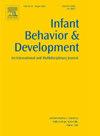Caregiver broader autism phenotype does not moderate the effect of early caregiver-mediated support on infant language outcomes
IF 2
3区 心理学
Q3 PSYCHOLOGY, DEVELOPMENTAL
引用次数: 0
Abstract
Caregiver-mediated supports in general have shown mixed evidence for enhancing language outcomes in infants at higher likelihood of autism. While caregivers play a substantial role in caregiver-mediated supports, little is known about whether caregivers’ own subclinical autistic features – known as broader autism phenotype (BAP) – may moderate infant language outcomes. In secondary analysis of trial data, we examined whether caregiver BAP moderated the effectiveness of the iBASIS caregiver-mediated support program (received when infants were mean aged 12–18 months) for infant language outcomes (measured on parent-reported and direct assessment of receptive and expressive language). While lower caregiver BAP was linked to increased parent-reported infant vocabulary growth in general terms, it did not actually moderate the effect of the caregiver-mediated support program on those infant language outcomes. In relative terms therefore, infants of caregivers with both higher and lower BAP benefited equally from this support on parent-report compared to the comparison group. Caregiver BAP is associated with slower vocabulary growth in infants, but caregivers with autistic features can be recommended for this caregiver-mediated video-feedback based program, as their infants benefitted from such support.
照顾者广泛的自闭症表型不能调节早期照顾者介导的支持对婴儿语言结果的影响
一般来说,照顾者介导的支持对提高自闭症可能性较高的婴儿的语言结果有不同的证据。虽然照顾者在照顾者介导的支持中发挥着重要作用,但很少有人知道照顾者自己的亚临床自闭症特征-被称为更广泛的自闭症表型(BAP) -是否会调节婴儿的语言结果。在对试验数据的二次分析中,我们检查了照顾者BAP是否会调节iBASIS照顾者介导的支持计划(在婴儿平均年龄12-18个月时接受)对婴儿语言结局(通过父母报告和直接评估接受性和表达性语言来衡量)的有效性。虽然一般而言,较低的照顾者BAP与父母报告的婴儿词汇增长增加有关,但它实际上并没有缓和照顾者介导的支持计划对婴儿语言结果的影响。因此,相对而言,与对照组相比,BAP较高和较低的照顾者的婴儿从父母报告的支持中受益相同。照顾者BAP与婴儿词汇增长缓慢有关,但可以推荐具有自闭症特征的照顾者参加这个照顾者介导的基于视频反馈的项目,因为他们的婴儿从这种支持中受益。
本文章由计算机程序翻译,如有差异,请以英文原文为准。
求助全文
约1分钟内获得全文
求助全文
来源期刊

Infant Behavior & Development
PSYCHOLOGY, DEVELOPMENTAL-
CiteScore
4.10
自引率
4.80%
发文量
94
期刊介绍:
Infant Behavior & Development publishes empirical (fundamental and clinical), theoretical, methodological and review papers. Brief reports dealing with behavioral development during infancy (up to 3 years) will also be considered. Papers of an inter- and multidisciplinary nature, for example neuroscience, non-linear dynamics and modelling approaches, are particularly encouraged. Areas covered by the journal include cognitive development, emotional development, perception, perception-action coupling, motor development and socialisation.
 求助内容:
求助内容: 应助结果提醒方式:
应助结果提醒方式:


